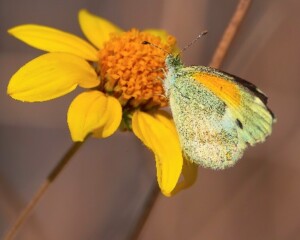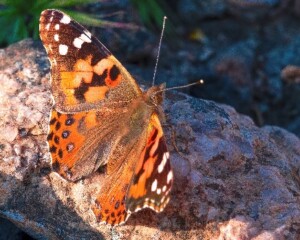LONG-TERM BUTTERFLY MONITORING
Why It Matters
In addition to being pretty and fun to watch, butterflies play important roles in the ecosystem. Both their larval and adult forms are important parts of the food web. Many help pollinate plants, and some serve as natural pest control. Butterflies are also excellent bioindicators of environmental change. Because they are popular and easy to identify, butterflies are widely used as indicators of terrestrial insect biodiversity trends; they experience comparable environmental pressures from habitat degradation, climate change, and land use change as other insect taxa.1–3
However, an estimated 75% of all butterfly species are in decline, compared to 25% that are increasing in abundance.4,5 These declines have been occurring over the last five decades, largely due to habitat loss and agricultural intensification, including the use of pesticides,6 and appear to be occurring even in protected areas.7 Specialist butterflies, for example those with specific dietary or habitat requirements, appear to be at much higher risk than those with more general habitat and food needs.6,7 Climate changes, such as chronic drought or high climatic fluctuation, also threatens butterfly persistence because butterflies are closely linked to environmental factors, such as annual rainfall and seasonal changes. Seasonal monitoring provides critical insight into how long- and short-term factors, as well as natural vs. anthropogenic changes, affect the populations.6,7 Understanding these overall changes in the ecosystem is critical so that relevant management actions can be implemented.
The Conservancy’s Work
The Conservancy has conducted annual fall butterfly counts at six sites in Scottsdale’s McDowell Sonoran Preserve since 2014. In 2017, an annual spring count was added at the same sites to better assess seasonal variances. These sites represent different plant community types across the Preserve. Participants follow the same route during each count to ensure accurate comparison between seasons and years.
The information collected is part of a national count overseen by the North American Butterfly Association (NABA). Data collected in the Preserve allows for comparisons of relative abundance across seasons and years but also other sites in the region and nationwide. These comparisons provide understanding of species trends across large scales.
What’s Been Found
Through these surveys, 58 butterfly species have been observed in the Preserve. Number of species and individuals varies with each count, with a high range of nearly 10,000 individuals in Fall of 2021 to a low of just 25 individuals in Fall 2020. In especially dry years, when host and food plants are rare or dormant, there are fewer species of butterflies and lower numbers of individual butterflies overall. This raises concerns of the effects of extended dry conditions that are predicted with climate change. Through surveys, the long-term trends can be assessed and any species declines identified. With the knowledge of habitat and life cycle requirements, conservation interventions can be implemented as needed, such as protecting or restoring important host plant species. The Conservancy’s documented Preserve Butterfly List is available on our website.
How You Can Help
Tracking biodiversity trends is one of the best ways we can protect Sonoran Desert species and their habitats. That’s why we need your support. You can ensure the desert will continue to thrive and be a place to enjoy for all, now and for future generations to come.
- Learn more about butterflies by attending the Conservancy’s semi-annual butterfly workshops or purchasing the plant and butterfly ID guides available online.
- Report your butterfly observations via iNaturalist
- Be butterfly friendly!
- Plant a butterfly garden
- Don’t use pesticides in your garden
- Reduce use of chemicals by buying organic
- Make a gift to McDowell Sonoran Conservancy or volunteer as a Conservancy Steward
Partner:
Ronald Rutowski, ASU Emeritus Professor, School of Life Sciences
McDowell Sonoran Conservancy Contact:
Jessie Dwyer | 480-998-7971 ext. 104 | jessie@mcdowellsonoran.org
15300 North 90th Street, Suite 400, Scottsdale, Arizona, 85260 | 480-998-7971


Literature cited:
- Brereton, T., Roy, D. B., Middlebrook, I., Botham, M. & Warren, M. The development of butterfly indicators in the United Kingdom and assessments in 2010. Journal of Insect Conservation 15, 139–151 (2011).
- Thomas, J. A. Monitoring change in the abundance and distribution of insects using butterflies and other indicator groups. Philosophical Transactions of the Royal Society B: Biological Sciences 360, 339–357 (2005).
- Dennis, E. B., Morgan, B. J. T., Roy, D. B. & Brereton, T. M. Urban indicators for UK butterflies. Ecological Indicators 76, 184–193 (2017).
- Wepprich, T., Adrion, J. R., Ries, L., Wiedmann, J. & Haddad, N. M. Butterfly abundance declines over 20 years of systematic monitoring in Ohio, USA. PLoS ONE 14, 1–21 (2019).
- Van Swaay, C. et al. European red list of butterflies. Publications Office of the European Union (2010). doi:10.2779/83897.
- Sánchez-Bayo, F. & Wyckhuys, K. A. G. Worldwide decline of the entomofauna: A review of its drivers. Biological Conservation 232, 8–27 (2019).
- Wagner, D. L. Insect declines in the anthropocene. Annual Review of Entomology 65, 457–480 (2020).
DISCOVER MORE
Resources
Parsons May, 2021 Update (Video)
Protect Your Sonoran Desert
The Power to Sustain the Sonoran Desert for Future Generations is Yours

